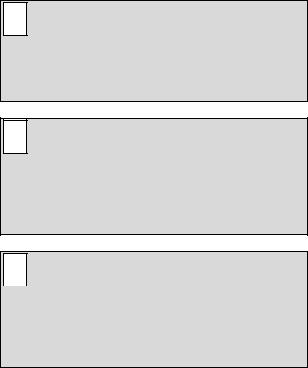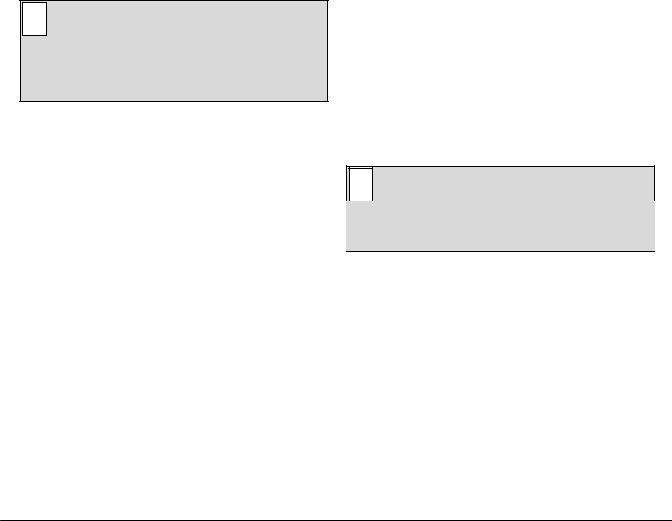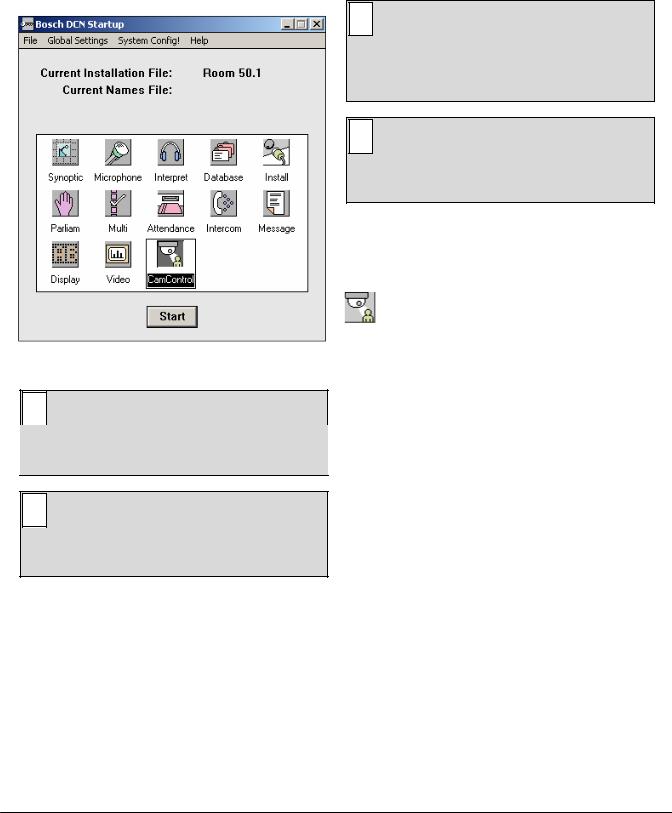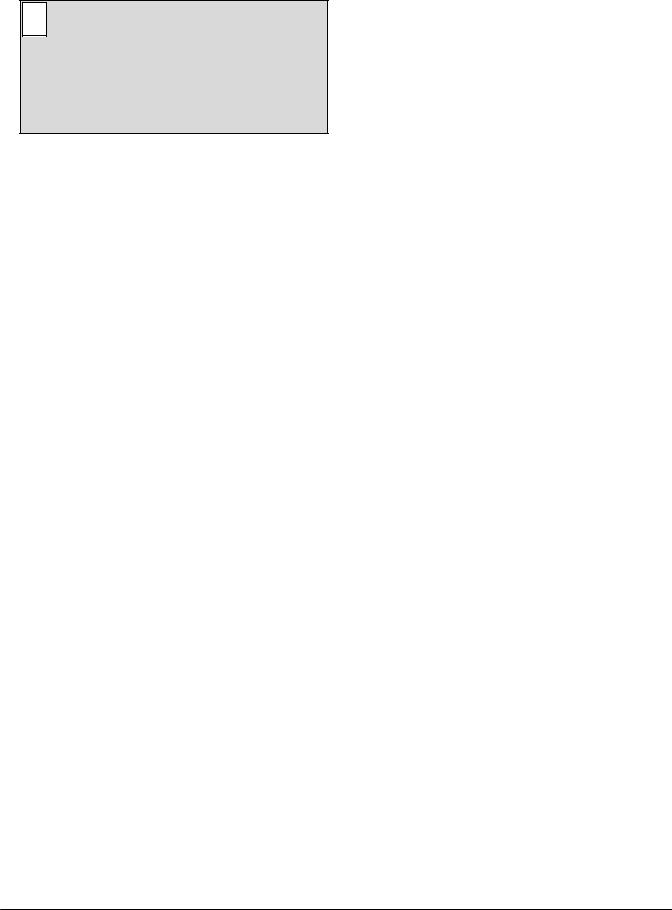Bosch LBB 4188, LBB 4162/00, LBB 4188/00 User Manual

DCN Next Generation
Automatic Camera Control
en Software User Manual
LBB 4162/00
LBB 4188/00

About this manual
This user manual is divided into three chapters. Chapters 1 and 2 provide background information and chapter 3 provides detailed user information as follows:
•Chapter 1 - Automatic Camera Control - containing general information about the Automatic Camera Control software, and the two different versions available.
•Chapter 2 - Getting Started - containing details about installing the stand-alone version of the software, and information about starting the application from the Startup screen and from a shortcut icon. There is also a description of the Help facility.
•Chapter 3 - Using Automatic Camera Control - containing details about configuring the software, assigning cameras to seat/unit numbers, specifying camera type, editing camera IDs, importing and exporting camera settings and printing Camera Installation files.
Manual conventions
For clarity this user manual uses consistent styles, symbols and typographical conventions. They are:
iNote
General notes are contained within rules and indicated with this symbol at the left margin. Notes are used to draw attention to special actions or information.
iCaution
A caution is contained within rules and indicated with this symbol at the left margin. Cautions are used to draw attention to actions or commands that could lead to a loss of information or damage to equipment
iTip
A tip is contained within a box and indicated with this symbol at the left margin. Tips are used to provide supplementary information that may make an action quicker or easier to carry out.
•An action (to be carried out by the user) is shown with a larger round bullet mark.
Typographical conventions
The following typographical conventions (text styles) are used in this manual:
•Typed input - information to be typed in using the keyboard is shown as:
Filename
•Single key - input via a single key (or keys) on the keyboard is shown as:
<enter>, <shift>, etc.
•Multiple keys - input via a combination of keys pressed together is shown as:
<ctrl>+<p>, <alt>+<f4>
•Screen text - information that appears on screen is shown as:
‘Choose Startup Modules:’
Hyperlinks
This manual is also available as a digital document in the Adobe Portable Document Format (PDF). All references to pages, figures, tables, etc. in this digital document contain hyperlinks to the referenced location.

DCN Next Generation Automatic Camera Control |
en | 3 |
|
|
Table of contents
1 |
Automatic camera control .................................... |
4 |
1.1 |
About Automatic Camera Control ...................... |
4 |
1.1.1 |
What is Automatic Camera Control? ................ |
4 |
1.1.2 |
Camera Control in congress applications ........ |
4 |
1.2Stand-alone and PC controlled system
|
versions..................................................................... |
4 |
1.2.1 |
Differences between stand-alone and PC |
|
|
controlled systems ................................................. |
4 |
1.3 |
Overview of Automatic Camera Control ........... |
4 |
1.3.1 |
Systems using Control PC................................... |
4 |
1.3.2 |
Stand-alone systems ............................................. |
4 |
2 |
Getting started............................................................ |
5 |
2.1Starting the Automatic Camera Control
|
software .................................................................... |
5 |
2.1.1 |
The Startup screen ................................................ |
5 |
|
Selecting an installation (and a names) file...... |
5 |
|
The Automatic Camera Control icon ................. |
5 |
2.2 |
Installing the stand-alone version........................ |
5 |
2.2.1 |
PC requirements and settings............................. |
5 |
2.2.2 |
Installing the stand-alone software..................... |
5 |
2.3 |
Using Help ............................................................... |
6 |
2.3.1 |
The Help menu........................................................ |
6 |
2.3.2 |
Index .......................................................................... |
6 |
2.3.3 |
Keyboard .................................................................. |
6 |
2.3.4 |
Commands............................................................... |
6 |
2.3.5 |
Procedures............................................................... |
6 |
2.3.6 |
Glossary.................................................................... |
6 |
2.3.7 |
Using Help ............................................................... |
7 |
2.3.8 |
About ......................................................................... |
7 |
3 |
Using Automatic Camera Control..................... |
8 |
3.1 |
The camera installation main window ................ |
8 |
3.1.1 |
The menu bar........................................................... |
9 |
3.2 |
Assigning cameras to seat/unit numbers ......... |
9 |
3.2.1 |
Specifying the overview camera ....................... |
10 |
3.2.2 |
Selecting a seat (or unit) number ..................... |
10 |
3.2.3 |
Selecting camera number .................................. |
10 |
3.2.4 |
Editing camera ID ................................................. |
10 |
3.2.5 |
Specifying camera type....................................... |
11 |
3.2.6 |
Entering seat (or unit) text .................................. |
11 |
3.2.7 |
Inserting seat (or unit) numbers and camera |
|
|
settings.................................................................... |
12 |
3.2.8 |
Editing entries in the ‘Assignments:’ list ......... |
13 |
3.2.9 |
Deleting a camera assignment from the |
|
|
‘Assignments:’ list................................................. |
13 |
3.3 |
System setting....................................................... |
13 |
3.3.1 |
Screenline usage.................................................. |
14 |
3.3.2 |
Double seat (or unit) text .................................... |
14 |
3.3.3 |
Camera override ................................................... |
14 |
3.3.4 |
Camera movement time ...................................... |
14 |
3.3.5 |
Number of audience monitors ........................... |
14 |
3.4 |
The file menu ......................................................... |
15 |
3.4.1 |
Camera activity...................................................... |
15 |
3.4.2 |
Clear all ................................................................... |
15 |
3.4.3 |
Printing.................................................................... |
15 |
3.4.4 |
Importing and exporting Camera Installation |
|
|
files .......................................................................... |
15 |
3.4.5 |
Importing Camera Installation files................... |
16 |
3.4.6 |
Exporting Camera Installation files................... |
16 |
3.5 |
Exiting Automatic Camera Control................... |
16 |
3.5.1Temporarily exiting Automatic Camera Control16
3.5.2Permanently exiting Automatic Camera
Control .................................................................... |
17 |
Bosch Security Systems B.V. | 2005 January | 9922 141 70491

DCN Next Generation Automatic Camera Control |
en | 4 |
|
|
1Automatic camera control
1.1 About Automatic Camera Control
1.1.1 What is Automatic Camera Control?
The Automatic Camera Control software is designed to interface DCN Next Generation congress systems with Bosch Allegiant switchers or a single Bosch AutoDome camera. It selects fixed or pre-positioned cameras to be activated to display the current active speaker at a conference.
1.1.2 Camera Control in congress applications
When a chairman’s or delegate’s microphone is activated on the equipment, the camera assigned to that position is activated. When no microphones are active, an overview camera is automatically selected. The image can be displayed on hall displays or other monitors together with information about the current speaker if required (such as delegate identification). The system operator has a monitor, which also displays information about which camera is active. This system provides an extra dimension to congress and conference proceedings.
iNote
The Allegiant video control switcher cannot display graphic characters that are used in certain non-European and non-US languages such as Chinese.
1.2 Stand-alone and PC controlled system versions
There are two versions of DCN Automatic Camera Control software:
•PC controlled version is for systems with a CCU and a control PC. The activation and installation of the cameras is integrated into the PC control software.
•Standalone version is for stand-alone systems without PC control.
1.2.1 Differences between stand-alone and PC controlled systems
The main difference is that the stand-alone version operates without a control PC. A PC needs only be connected for programming the CCU. The PC running the stand-alone software is disconnected from the CCU after the software has been used, but in a DCN Next Generation system with control PC, the PC remains connected to the CCU.
There are also minor differences in functionality between the two software versions. These are described elsewhere in this manual.
1.3 Overview of Automatic Camera Control
An overview of the procedure for using the Automatic Camera Control software is given below.
1.3.1 Systems using Control PC
The Automatic Camera Control software is installed on the control PC. The control PC is connected to the CCU, which in turn is connected to delegates’ contribution units. The CCU is also connected to a single AutoDome camera or an Allegiant video switcher, which in turn is connected to the cameras and monitors in the system. After connecting the system, the Automatic Camera Control software is used to configure the cameras. The control PC remains connected to the CCU while the system is being used.
1.3.2 Stand-alone systems
In stand-alone systems, a temporary PC connection to the CCU and AutoDome camera or Allegiant video switcher is needed during camera installation. The numbers assigned to the contribution units during system initialisation are coupled to camera positions. After configuration is complete, the PC is disconnected from the system, and a direct connection from the CCU to the AutoDome camera or the Allegiant video switcher is made. Operational camera control by the CCU is enabled during installation. To disable operational camera control, it is necessary to re-connect the installation PC and open the Camera Installation file.
iNote
For details on connections refer to the DCN Next Generation Installation and User Instructions.
Bosch Security Systems B.V. | 2005 January | 9922 141 70491

DCN Next Generation Automatic Camera Control |
en | 5 |
|
|
2Getting started
2.1Starting the Automatic Camera Control software
2.1.1 The Startup screen
The Automatic Camera Control program is started from the Startup screen (shown below).
Figure 1 The Startup screen.
iNote
For starting the Startup program from an icon in the desktop, refer to the Startup user manual.
iNote
The standalone version of the Automatic Camera Control software is started from the windows ‘Start Programs’ menu.
The Automatic Camera Control PC controlled version uses two user-created files that contain important information about the installed hardware configuration and about delegates’ names. These files are:
•Installation file - containing information about channel assignment and the numbers that have been assigned to all microphones connected to the system. These seat numbers are assigned using the System Installation software module LBB 4185/00.
•Names file - containing information about the name, seat number and other conference and personal details of participating delegates. Names files are created using Delegate Database.
The seat numbers defined in System Installation are used to assign cameras connected to the system. The seat numbers are assigned using the System Installation software (LBB4185).
iNote
An installation file must be open before camera installation is possible. However, the Automatic Camera Control software can be started without an installation file being open.
iNote
The stand-alone version of the Automatic Camera Control software does not use other software modules.
Selecting an installation (and a names) file
For details on selecting an installation (and a names) file, please refer to the Startup user manual (LBB 4190).
The Automatic Camera Control icon
For details on the Automatic Camera Control icon and how to start Automatic Camera Control from Startup, please refer to the Startup user manual (LBB 4190).
2.2 Installing the stand-alone version
2.2.1 PC requirements and settings
For information about PC requirements and settings, please refer to the DCN Next Generation Installation and User Instruction.
2.2.2 Installing the stand-alone software
To install the stand-alone version of the Automatic Camera Control software:
•Insert the CDROM with type number LBB 4162/00.
•Select ‘Run...’ from the ‘Start’ menu on the Windows desktop.
•Type d:\setup (where d is the CDROM) on the command line which appears.
•Follow the on-screen instructions.
When installation has been successfully completed, a new program group called Standalone Camera
Bosch Security Systems B.V. | 2005 January | 9922 141 70491

DCN Next Generation Automatic Camera Control |
en | 6 |
|
|
Control Installation is created. Please refer to paragraph 2.1, for information about starting the module.
iNote
Before beginning camera installation, it is important to make sure that the Allegiant video switcher, system cameras and monitors are properly connected and installed. For more information, refer to the DCN Next Generation Installation and User Instructions.
2.3 Using Help
2.3.1 The Help menu
The ‘Help’ menu in the title bar contains commands for an on-screen help facility. This help facility contains information on all commands in the ‘File’ menu, on which keyboard keys are functional, a description of how to use the software, information on how to use the help facility itself, plus an index and a glossary of terms. All information contained in this user manual is also found in the ‘Help’ facility.
The ‘Help’ facility contains the following options:
•Index
•Keyboard
•Commands
•Procedures
•Glossary
•Using Help
•About…
A list of different key types is given. For more information on any key type contained in the list:
•Click on the required key type in the list.
An on-screen page with the requested information will appear.
2.3.4 Commands
This gives information on all menu options, covering the ‘File’, ‘Edit’, ‘View’, ‘Settings’ and ‘Help’ menus. To access the ‘Commands’ help facility:
• Select the ‘Help’ menu and click on
‘Commands’.
A list of menu groups is given. For more information on any menu group contained in the list:
•Click on the required menu group in the list.
A list of options in the selected menu group is given. For more information on any option contained in the list:
•Click on the required option in the list.
An on-screen page with the requested information will appear.
2.3.5 Procedures
This gives information on how to use the software. To access the ‘Procedures’ help facility:
• Select the ‘Help’ menu and click on
‘Procedures’.
A list of topics is given. For more information on any topic contained in the list:
2.3.2 Index |
• Click on the required topic in the list. |
To access the index: |
A list of options for the selected topic is given. For |
|
•Select the ‘Help’ menu and click on ‘Index’. more information on any option contained in the list:
A full list of subjects covered by the help facility is given in alphabetical order. For more information on any subject contained in the index:
•Click on the required subject in the index.
•Click on the required option in the list.
An on-screen page with the requested information will appear.
An on-screen page with the requested information will appear.
2.3.3 Keyboard
This gives information on which keys on your keyboard can be used with the software. This includes using keys to activate menu items, to move around in dialogue boxes, for short cuts, and to select options from the main window. To access the ‘Keyboard’ help facility:
• Select the ‘Help’ menu and click on
‘Keyboard’.
2.3.6 Glossary
To access the glossary:
• Select the ‘Help’ menu and click on
‘Glossary’.
A list of terms used in the help facility is given in alphabetical order. For more information on any term contained in the glossary:
•Click on the required subject in the index.
A window with the requested information will appear.
Bosch Security Systems B.V. | 2005 January | 9922 141 70491
